Comprehensive Validation of MODIS-Derived Instantaneous Air Temperature and Daily Minimum Temperature at Nighttime
Abstract
1. Introduction
2. Study Area and Data
2.1. Study Area
2.2. Satellite Data
2.3. Meteorological Observations
3. Methodology
3.1. Reconstruction of Atmospheric Profile
3.2. Extraction from Land Surface Temperature
3.3. Validation and Comparison Framework
4. Results
4.1. Overall Performance of Instantaneous Ta and Tmin Estimation
4.2. Spatial Distribution of Errors
4.3. Seasonal Analysis of Errors
4.4. Altitude Dependence of Errors
5. Discussion
5.1. Comparison of Data Applicability
5.2. Temperature Estimation Error Analysis
5.3. Future Prospects
6. Conclusions
Author Contributions
Funding
Data Availability Statement
Acknowledgments
Conflicts of Interest
References
- Joy, A.; Satheesan, K.; Paul, A. High-resolution maximum air temperature estimation over India from MODIS data using machine learning. Remote Sens. Appl. Soc. Environ. 2025, 37, 101463. [Google Scholar] [CrossRef]
- Jia, A.; Liang, S.; Wang, D. Generating a 2-km, all-sky, hourly land surface temperature product from Advanced Baseline Imager data. Remote Sens. Environ. 2022, 278, 113105. [Google Scholar] [CrossRef]
- Fu, P.; Weng, Q. Variability in annual temperature cycle in the urban areas of the United States as revealed by MODIS imagery. ISPRS J. Photogramm. Remote Sens. 2018, 146, 65–73. [Google Scholar] [CrossRef]
- Wang, Q.; Tang, Y.; Tong, X.; Atkinson, P.M. Filling gaps in cloudy Landsat LST product by spatial-temporal fusion of multi-scale data. Remote Sens. Environ. 2024, 306, 114142. [Google Scholar] [CrossRef]
- Yao, R.; Wang, L.; Huang, X.; Li, L.; Sun, J.; Wu, X.; Jiang, W. Developing a temporally accurate air temperature dataset for Mainland China. Sci. Total. Environ. 2020, 706, 136037. [Google Scholar] [CrossRef]
- Zakšek, K.; Schroedter-Homscheidt, M. Parameterization of air temperature in high temporal and spatial resolution from a combination of the SEVIRI and MODIS instruments. ISPRS J. Photogramm. Remote Sens. 2009, 64, 414–421. [Google Scholar] [CrossRef]
- Lin, S.; Moore, N.J.; Messina, J.P.; DeVisser, M.H.; Wu, J. Evaluation of estimating daily maximum and minimum air temperature with MODIS data in east Africa. Int. J. Appl. Earth Obs. Geoinf. 2012, 18, 128–140. [Google Scholar] [CrossRef]
- Zhu, W.; Lű, A.; Jia, S.; Yan, J.; Mahmood, R. Retrievals of all-weather daytime air temperature from MODIS products. Remote Sens. Environ. 2017, 189, 152–163. [Google Scholar] [CrossRef]
- Yoo, C.; Im, J.; Park, S.; Quackenbush, L.J. Estimation of daily maximum and minimum air temperatures in urban landscapes using MODIS time series satellite data. ISPRS J. Photogramm. Remote Sens. 2018, 137, 149–162. [Google Scholar] [CrossRef]
- Shen, H.; Jiang, Y.; Li, T.; Cheng, Q.; Zeng, C.; Zhang, L. Deep learning-based air temperature mapping by fusing remote sensing, station, simulation and socioeconomic data. Remote Sens. Environ. 2020, 240, 111692. [Google Scholar] [CrossRef]
- Stisen, S.; Sandholt, I.; Nørgaard, A.; Fensholt, R.; Eklundh, L. Estimation of diurnal air temperature using MSG SEVIRI data in West Africa. Remote Sens. Environ. 2007, 110, 262–274. [Google Scholar] [CrossRef]
- Janatian, N.; Sadeghi, M.; Sanaeinejad, S.H.; Bakhshian, E.; Farid, A.; Hasheminia, S.M.; Ghazanfari, S. A statistical framework for estimating air temperature using MODIS land surface temperature data. Int. J. Climatol. 2017, 37, 1181–1194. [Google Scholar] [CrossRef]
- Coll, C.; Caselles, V.; Valor, E.; Niclòs, R. Comparison between different sources of atmospheric profiles for land surface temperature retrieval from single channel thermal infrared data. Remote Sens. Environ. 2012, 117, 199–210. [Google Scholar] [CrossRef]
- Famiglietti, C.A.; Fisher, J.B.; Halverson, G.; Borbas, E.E. Global Validation of MODIS Near-Surface Air and Dew Point Temperatures. Geophys. Res. Lett. 2018, 45, 7772–7780. [Google Scholar] [CrossRef]
- Leng, P.; Liao, Q.; Gao, M.; Duan, S.; Li, Z.; Zhang, X.; Shang, G. A Full Satellite-Driven Method for the Retrieval of Clear-Sky Evapotranspiration. Earth Space Sci. 2019, 6, 2251–2262. [Google Scholar] [CrossRef]
- Bisht, G.; Venturini, V.; Islam, S.; Jiang, L. Estimation of the net radiation using MODIS (Moderate Resolution Imaging Spectroradiometer) data for clear sky days. Remote Sens. Environ. 2005, 97, 52–67. [Google Scholar] [CrossRef]
- Seddon, A.W.R.; Macias-Fauria, M.; Long, P.R.; Benz, D.; Willis, K.J. Sensitivity of global terrestrial ecosystems to climate variability. Nature 2016, 531, 229–232. [Google Scholar] [CrossRef]
- Tang, B.; Li, Z.-L. Estimation of instantaneous net surface longwave radiation from MODIS cloud-free data. Remote Sens. Environ. 2008, 112, 3482–3492. [Google Scholar] [CrossRef]
- Hu, L.; Brunsell, N.A. A new perspective to assess the urban heat island through remotely sensed atmospheric profiles. Remote Sens. Environ. 2015, 158, 393–406. [Google Scholar] [CrossRef]
- Kim, J.; Hogue, T.S. Evaluation of a MODIS-Based Potential Evapotranspiration Product at the Point Scale. J. Hydrometeorol. 2008, 9, 444–460. [Google Scholar] [CrossRef]
- Bisht, G.; Bras, R.L. Estimation of net radiation from the MODIS data under all sky conditions: Southern Great Plains case study. Remote Sens. Environ. 2010, 114, 1522–1534. [Google Scholar] [CrossRef]
- Sobrino, J.A.; Jiménez-Muñoz, J.C.; Mattar, C.; Sòria, G. Evaluation of Terra/MODIS atmospheric profiles product (MOD07) over the Iberian Peninsula: A comparison with radiosonde stations. Int. J. Digit. Earth 2015, 8, 771–783. [Google Scholar] [CrossRef]
- Wang, Q.; Wang, X.; Zhou, Y.; Liu, D.; Wang, H. The dominant factors and influence of urban characteristics on land surface temperature using random forest algorithm. Sustain. Cities Soc. 2022, 79, 103722. [Google Scholar] [CrossRef]
- Hrisko, J.; Ramamurthy, P.; Yu, Y.; Yu, P.; Melecio-Vázquez, D. Urban air temperature model using GOES-16 LST and a diurnal regressive neural network algorithm. Remote Sens. Environ. 2020, 237, 111495. [Google Scholar] [CrossRef]
- Ullah, S.; Qiao, X.; Abbas, M. Addressing the impact of land use land cover changes on land surface temperature using machine learning algorithms. Sci. Rep. 2024, 14, 18746. [Google Scholar] [CrossRef]
- Xu, Z.; Yi, Z.; Wang, Y.; Wang, D.; Zhang, L.; Huo, H. Estimating near-surface air temperature in urban functional zones in China using spatial-temporal attention. Build. Environ. 2025, 276, 112860. [Google Scholar] [CrossRef]
- Benali, A.; Carvalho, A.C.; Nunes, J.P.; Carvalhais, N.; Santos, A. Estimating air surface temperature in Portugal using MODIS LST data. Remote Sens. Environ. 2012, 124, 108–121. [Google Scholar] [CrossRef]
- Shamir, E.; Georgakakos, K.P. MODIS Land Surface Temperature as an index of surface air temperature for operational snowpack estimation. Remote Sens. Environ. 2014, 152, 83–98. [Google Scholar] [CrossRef]
- Jin, Z.; Ma, Y.; Chu, L.; Liu, Y.; Dubrow, R.; Chen, K. Predicting spatiotemporally-resolved mean air temperature over Sweden from satellite data using an ensemble model. Environ. Res. 2022, 204, 111960. [Google Scholar] [CrossRef]
- Vancutsem, C.; Ceccato, P.; Dinku, T.; Connor, S.J. Evaluation of MODIS land surface temperature data to estimate air temperature in different ecosystems over Africa. Remote Sens. Environ. 2010, 114, 449–465. [Google Scholar] [CrossRef]
- Kloog, I.; Nordio, F.; Coull, B.A.; Schwartz, J. Predicting spatiotemporal mean air temperature using MODIS satellite surface temperature measurements across the Northeastern USA. Remote Sens. Environ. 2014, 150, 132–139. [Google Scholar] [CrossRef]
- Zhang, Z.; Du, Q. Merging framework for estimating daily surface air temperature by integrating observations from multiple polar-orbiting satellites. Sci. Total Environ. 2022, 812, 152538. [Google Scholar] [CrossRef]
- Zhu, W.; Lű, A.; Jia, S. Estimation of daily maximum and minimum air temperature using MODIS land surface temperature products. Remote Sens. Environ. 2013, 130, 62–73. [Google Scholar] [CrossRef]
- Zhang, W.; Zhang, B.; Zhu, W.; Tang, X.; Li, F.; Liu, X.; Yu, Q. Comprehensive assessment of MODIS-derived near-surface air temperature using wide elevation-spanned measurements in China. Sci. Total Environ. 2021, 800, 149535. [Google Scholar] [CrossRef]
- Zhong, H.; Zhou, J.; Tang, W.; Zhou, G.; Wang, Z.; Wang, W. Estimation of near-surface air temperature lapse rate based on MODIS data over the Tibetan Plateau. IEEE J. Sel. Top. Appl. Earth Obs. Remote Sens. 2023, 16, 4767–4777. [Google Scholar] [CrossRef]
- Labbi, A. Estimation of daytime near-surface air temperature from satellite data. Remote Sens. Appl. Soc. Environ. 2020, 18, 100305. [Google Scholar] [CrossRef]
- Zhang, D.; Xie, X.; Zhou, C. Spatial influence of exposure to green spaces on the climate comfort of urban habitats in China. Urb. Clim. 2023, 51, 101657. [Google Scholar] [CrossRef]
- Xing, J.; Wang, M.; Zhang, Z.; Gao, W.; Liu, X. Asymmetry in the intensity and frequency of extreme high temperature during daytime and nighttime in China in the summer 2022. Sci. Total Environ. 2025, 976, 179332. [Google Scholar] [CrossRef]
- Luo, M.; Ning, G.; Xu, F.; Wang, S.; Liu, Z.; Yang, Y. Observed heatwave changes in arid northwest China: Physical mechanism and long-term trend. Atmos. Res. 2020, 242, 105009. [Google Scholar] [CrossRef]
- Gomis-Cebolla, J.; Jimenez, J.C.; Sobrino, J.A. LST retrieval algorithm adapted to the Amazon evergreen forests using MODIS data. Remote Sens. Environ. 2018, 204, 401–411. [Google Scholar] [CrossRef]
- Kim, K.Y.; Haagenson, R.; Kansara, P.; Rajaram, H.; Lakshmi, V. Augmenting daily MODIS LST with AIRS surface temperature retrievals to estimate ground temperature and permafrost extent in High Mountain Asia. Remote Sens. Environ. 2024, 305, 114075. [Google Scholar] [CrossRef]
- Román, M.O.; Justice, C.; Paynter, I.; Boucher, P.B.; Devadiga, S.; Endsley, A.; Erb, A.; Friedl, M.; Gao, H.; Giglio, L.; et al. Continuity between NASA MODIS Collection 6.1 and VIIRS Collection 2 land products. Remote Sens. Environ. 2024, 302, 113963. [Google Scholar] [CrossRef]
- Zhu, W.; Cao, M. Modification and validation of a new method to improve the accuracy of MODIS-derived dew point temperature over mainland China. Int. J. Digit. Earth 2023, 16, 3513–3535. [Google Scholar] [CrossRef]
- Recondo, C.; Corbea-Pérez, A.; Peón, J.; Pendás, E.; Ramos, M.; Calleja, J.F.; de Pablo, M.Á.; Fernández, S.; Corrales, J.A. Empirical models for estimating air temperature using MODIS land surface temperature (and spatiotemporal variables) in the Hurd Peninsula of Livingston Island, Antarctica, between 2000 and 2016. Remote Sens. 2022, 14, 3206. [Google Scholar] [CrossRef]
- Rhee, J.; Im, J. Estimating High Spatial Resolution Air Temperature for Regions with Limited in situ Data Using MODIS Products. Remote Sens. 2014, 6, 7360–7378. [Google Scholar] [CrossRef]
- Zhao, B.; Sun, Z.; Wang, M.; Du, J.; Song, K. Tracking global large lake surface temperature variation from space using MODIS land surface temperature product. Ecol. Inform. 2025, 89, 103184. [Google Scholar] [CrossRef]
- Mildrexler, D.J.; Zhao, M.; Running, S.W. A global comparison between station air temperatures and MODIS land surface temperatures reveals the cooling role of forests. J. Geophys. Res. 2011, 116, G03025. [Google Scholar] [CrossRef]
- Guo, H.; Zhu, W.; Xiao, C.; Zhao, C.; Chen, L. High-precision estimation of pan-Arctic soil surface temperature from MODIS LST by incorporating multiple environment factors and monthly-based modeling. Int. J. Appl. Earth Obs. Geoinf. 2024, 133, 104114. [Google Scholar] [CrossRef]
- Yu, W.; Ma, M.; Yang, H.; Tan, J.; Li, X. Supplement of the radiance-based method to validate satellite-derived land surface temperature products over heterogeneous land surfaces. Remote Sens. Environ. 2019, 230, 111188. [Google Scholar] [CrossRef]
- Mostovoy, G.V.; King, R.L.; Reddy, K.R.; Kakani, V.G.; Filippova, M.G. Statistical Estimation of Daily Maximum and Minimum Air Temperatures from MODIS LST Data over the State of Mississippi. GISci. Remote Sens. 2006, 43, 78–110. [Google Scholar] [CrossRef]
- Wan, Z. New refinements and validation of the Collection-6 MODIS land-surface temperature/emissivity product. Remote Sens. Environ. 2014, 140, 36–45. [Google Scholar] [CrossRef]
- Zhang, W.; Zhang, B.; Zhao, F.; Tang, X.; Gao, A.; Li, W.; Lan, X.; Tang, J. Influence of orographic effects on diurnal temperature differences in the near-surface vertical atmosphere over the Tibetan Plateau. Geogr. Res. 2023, 42, 713–727. [Google Scholar] [CrossRef]
- Wang, S.; Zhou, J.; Lei, T.; Wu, H.; Zhang, X.; Ma, J.; Zhong, H. Estimating Land Surface Temperature from Satellite Passive Microwave Observations with the Traditional Neural Network, Deep Belief Network, and Convolutional Neural Network. Remote Sens. 2020, 12, 2691. [Google Scholar] [CrossRef]
- Wang, Y.; Liu, J.; Zhu, W. Estimation of Instantaneous Air Temperature under All-Weather Conditions Based on MODIS Products in North and Southwest China. Remote Sens. 2023, 15, 2701. [Google Scholar] [CrossRef]
- Lin, X.; Zhang, W.; Huang, Y.; Sun, W.; Han, P.; Yu, L.; Sun, F. Empirical Estimation of Near-Surface Air Temperature in China from MODIS LST Data by Considering Physiographic Features. Remote Sens. 2016, 8, 629. [Google Scholar] [CrossRef]
- Yang, Y.; Cai, W.; Yang, J. Evaluation of MODIS Land Surface Temperature Data to Estimate Near-Surface Air Temperature in Northeast China. Remote Sens. 2017, 9, 410. [Google Scholar] [CrossRef]
- Hengl, T.; Heuvelink, G.B.M.; Stein, A. A generic framework for spatial prediction of soil variables based on regression-kriging. Geoderma 2004, 120, 75–93. [Google Scholar] [CrossRef]
- Qin, Z.; Karnieli, A.; Berliner, P. A mono-window algorithm for retrieving land surface temperature from Landsat TM data and its application to the Israel-Egypt border region. Int. J. Remote Sens. 2001, 22, 3719–3746. [Google Scholar] [CrossRef]
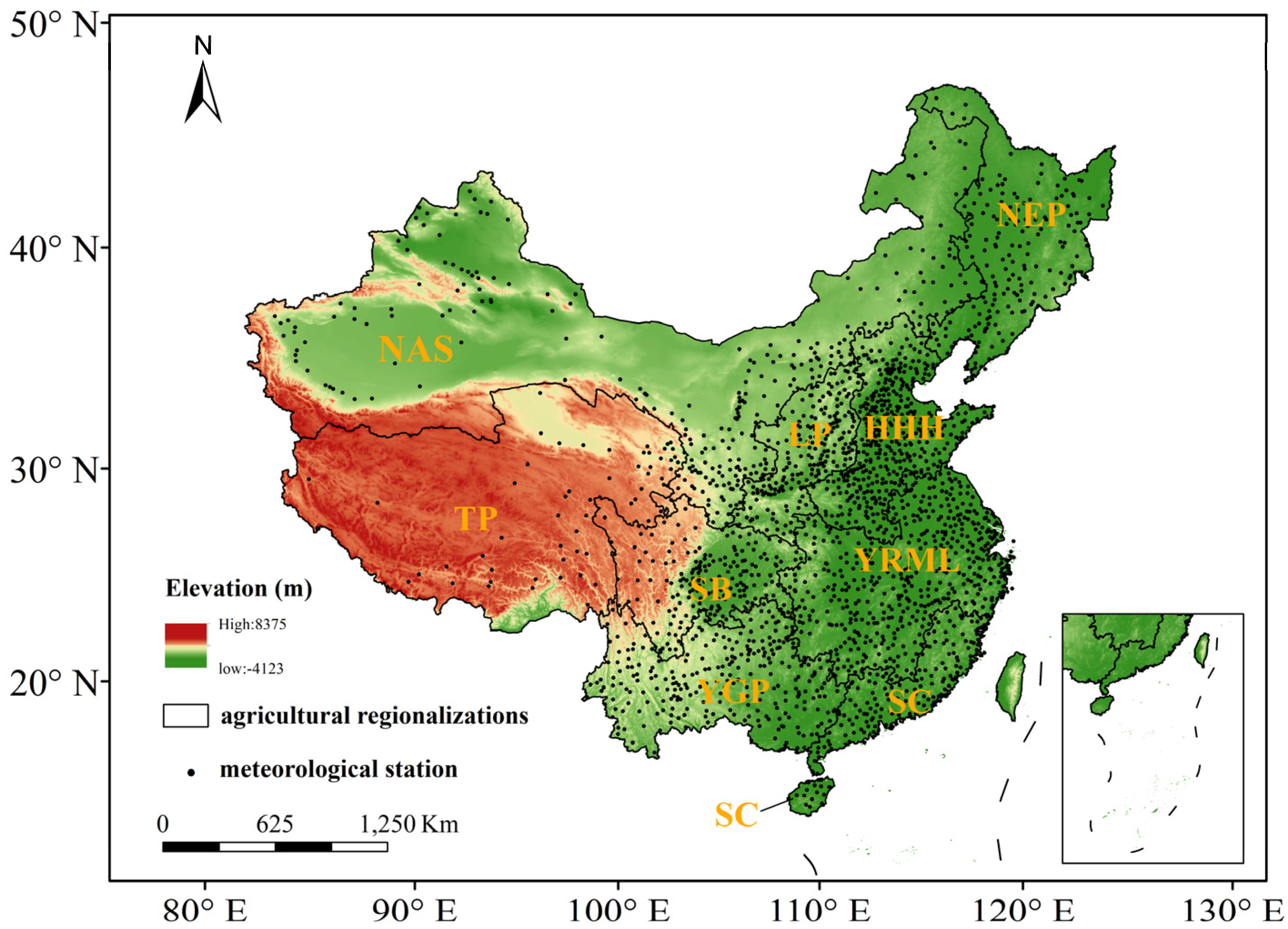
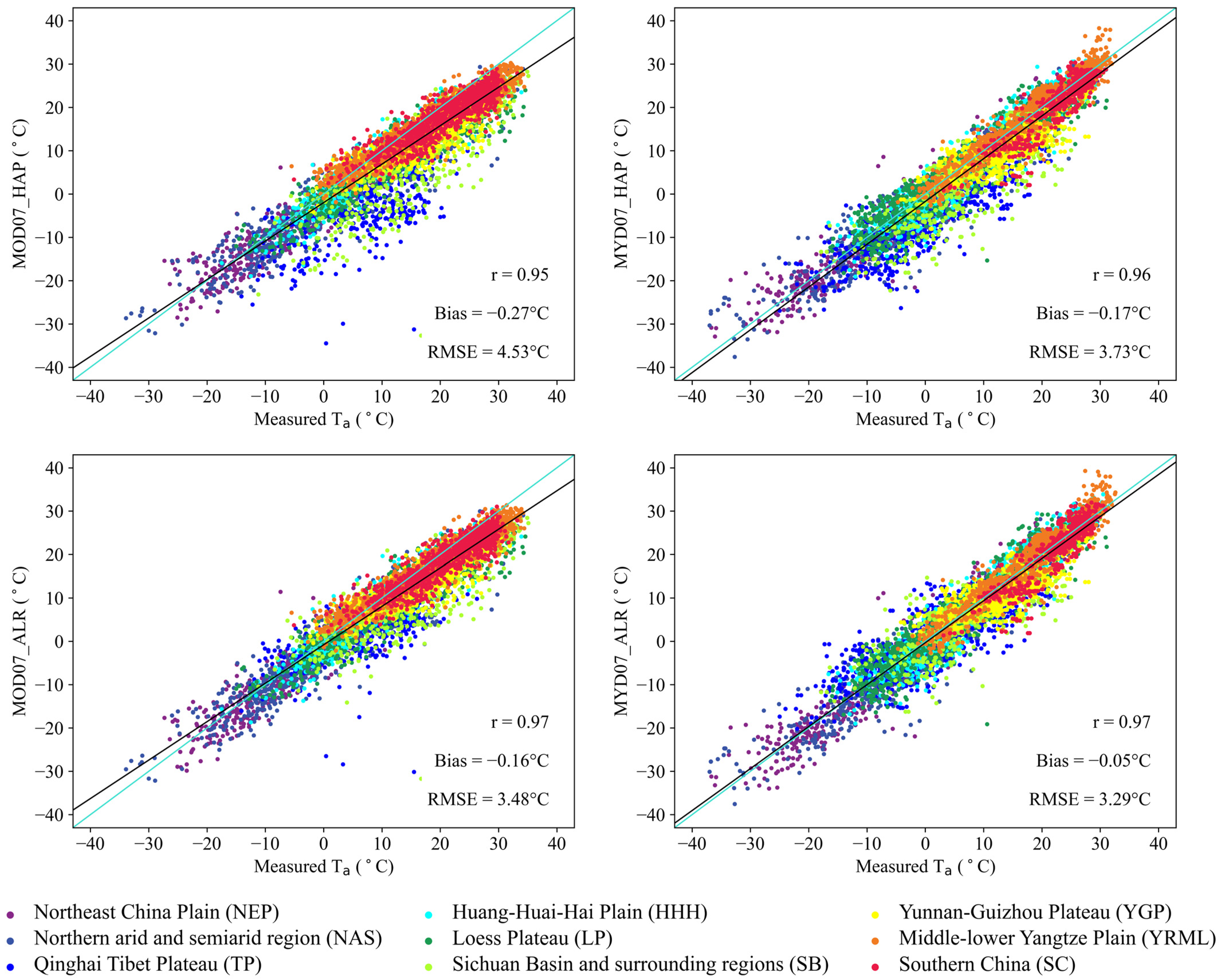
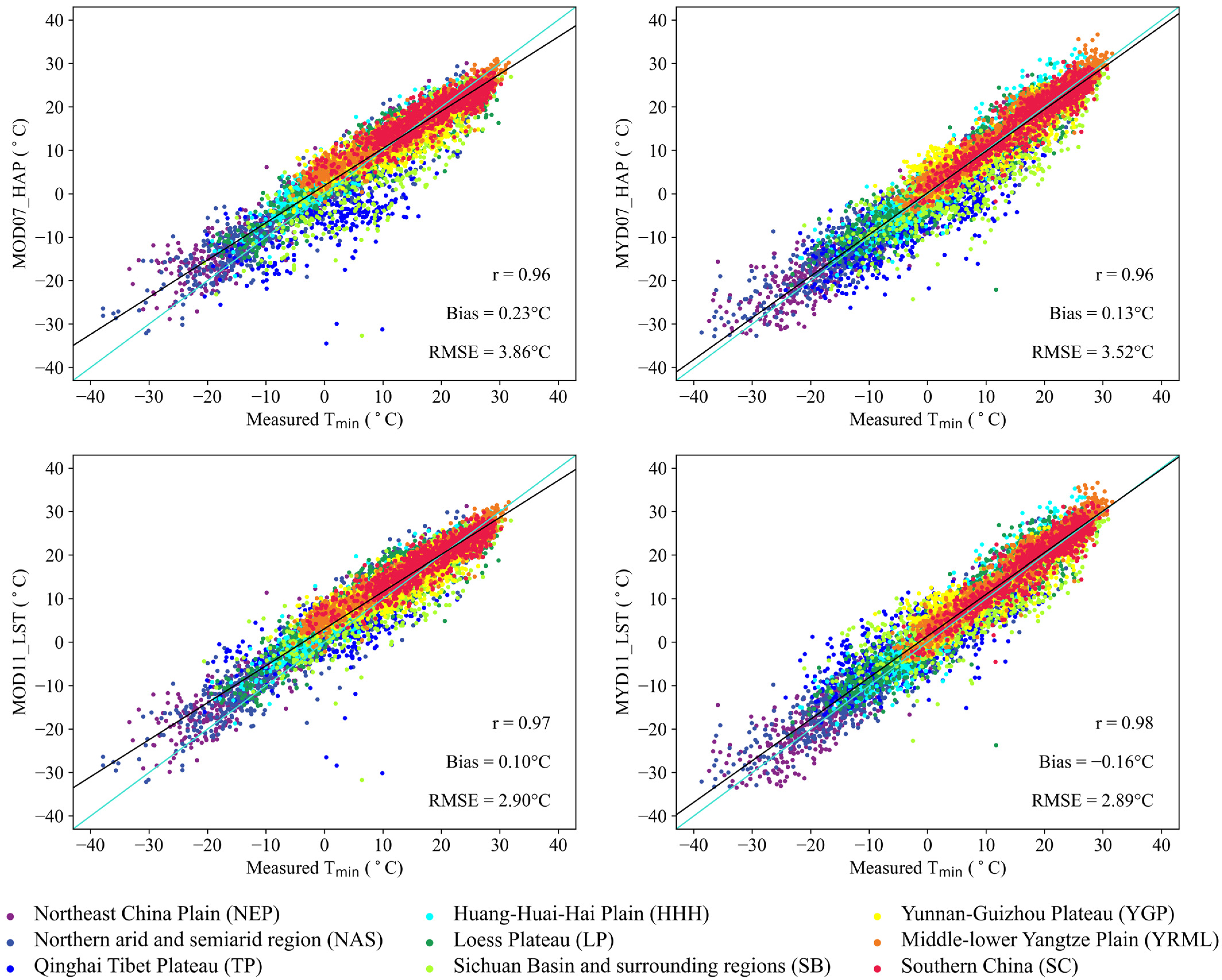

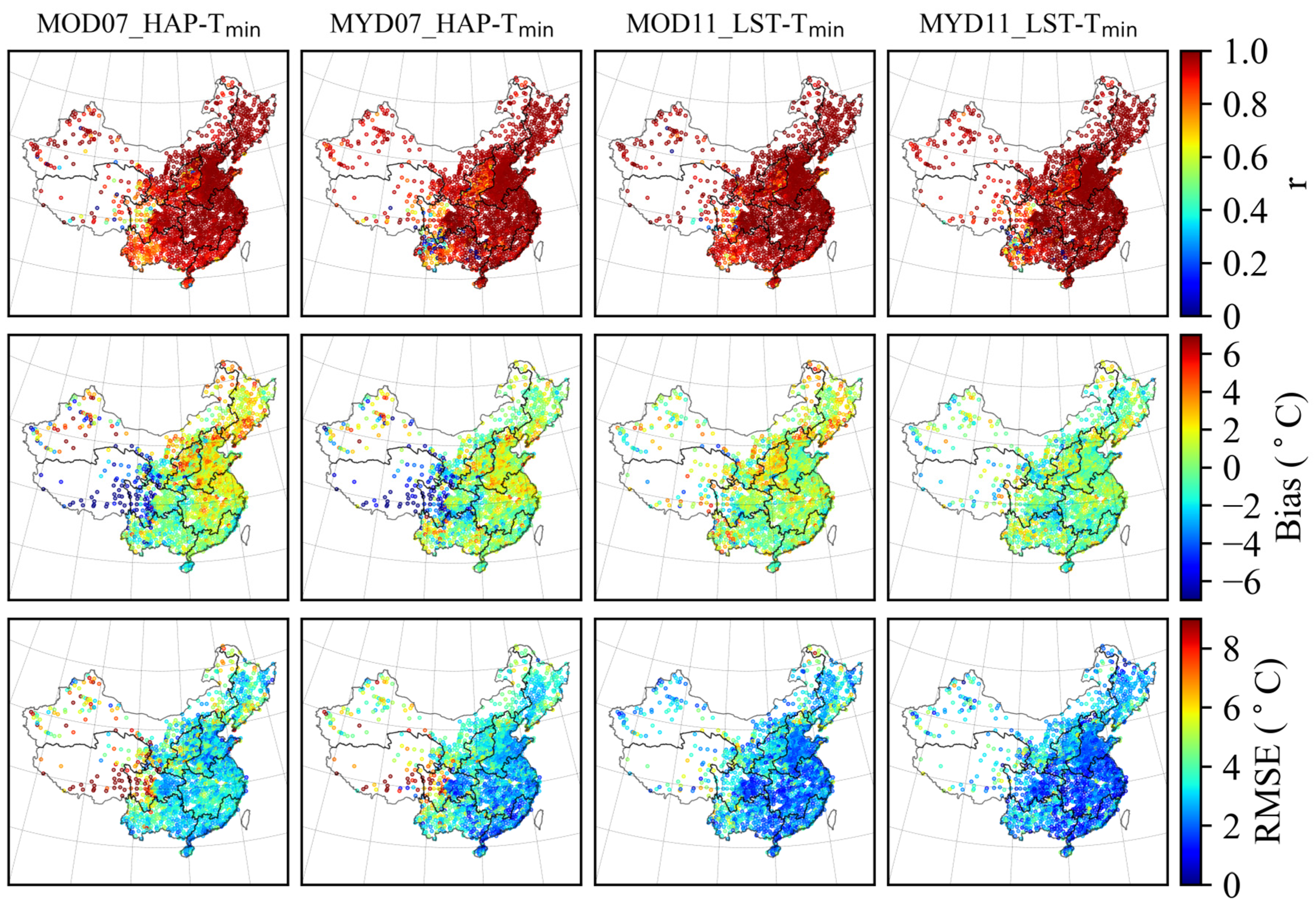

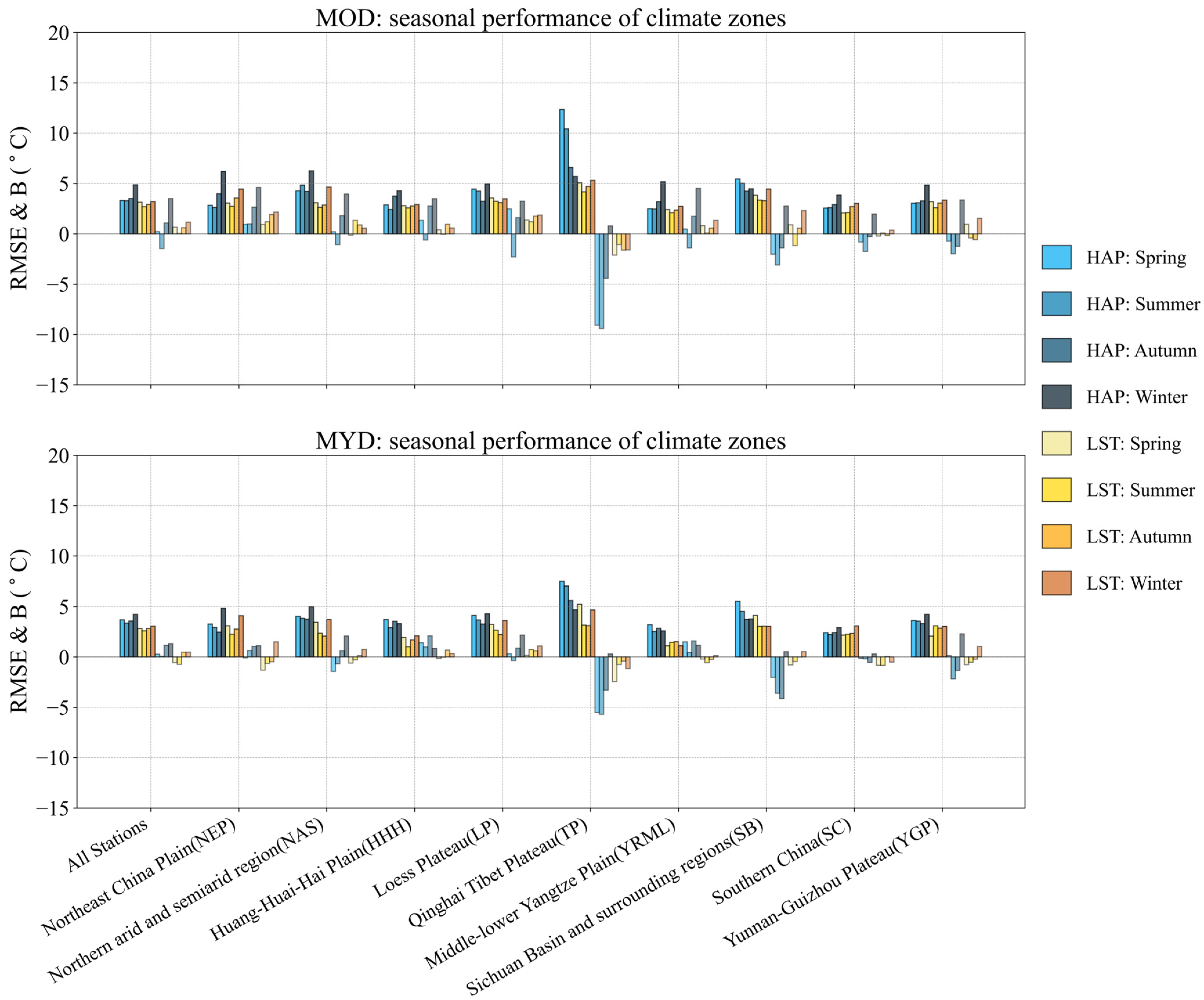
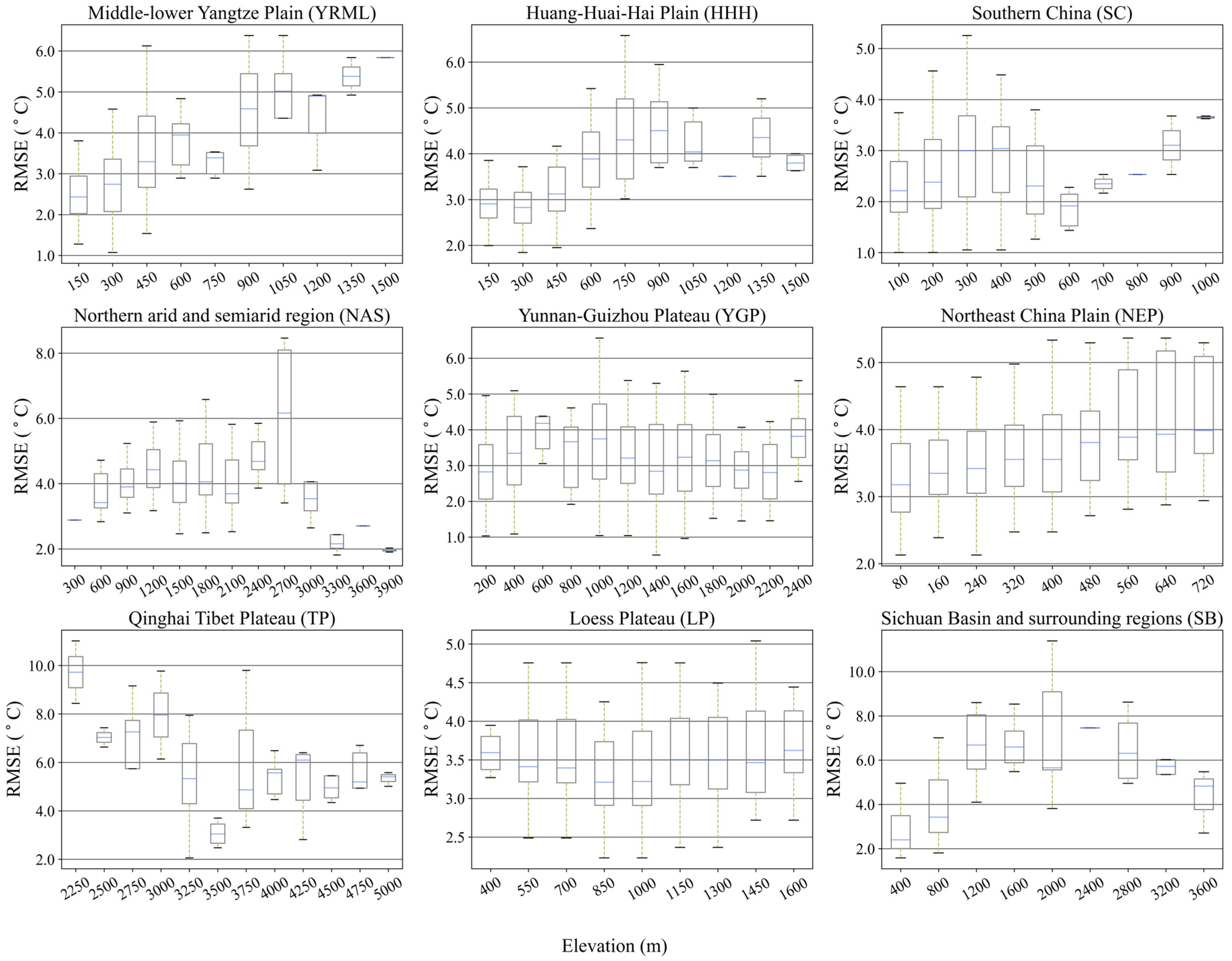
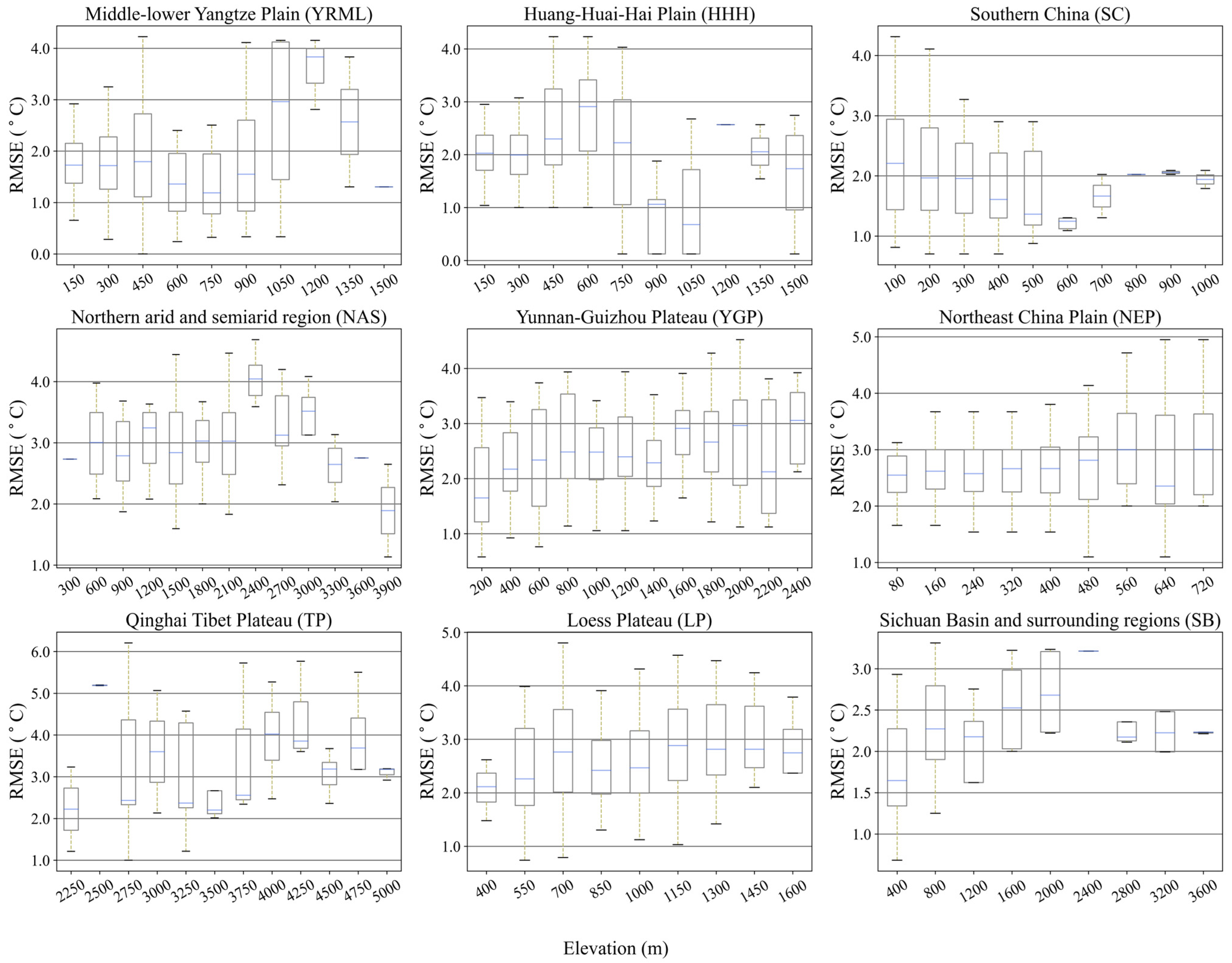
Disclaimer/Publisher’s Note: The statements, opinions and data contained in all publications are solely those of the individual author(s) and contributor(s) and not of MDPI and/or the editor(s). MDPI and/or the editor(s) disclaim responsibility for any injury to people or property resulting from any ideas, methods, instructions or products referred to in the content. |
© 2025 by the authors. Licensee MDPI, Basel, Switzerland. This article is an open access article distributed under the terms and conditions of the Creative Commons Attribution (CC BY) license (https://creativecommons.org/licenses/by/4.0/).
Share and Cite
Zhang, W.; Zhao, J.; Zhu, W.; Kong, Y.; Wan, B.; Liao, Y. Comprehensive Validation of MODIS-Derived Instantaneous Air Temperature and Daily Minimum Temperature at Nighttime. Remote Sens. 2025, 17, 1732. https://doi.org/10.3390/rs17101732
Zhang W, Zhao J, Zhu W, Kong Y, Wan B, Liao Y. Comprehensive Validation of MODIS-Derived Instantaneous Air Temperature and Daily Minimum Temperature at Nighttime. Remote Sensing. 2025; 17(10):1732. https://doi.org/10.3390/rs17101732
Chicago/Turabian StyleZhang, Wenjie, Jiarui Zhao, Wenbin Zhu, Yunbo Kong, Bingcheng Wan, and Yilan Liao. 2025. "Comprehensive Validation of MODIS-Derived Instantaneous Air Temperature and Daily Minimum Temperature at Nighttime" Remote Sensing 17, no. 10: 1732. https://doi.org/10.3390/rs17101732
APA StyleZhang, W., Zhao, J., Zhu, W., Kong, Y., Wan, B., & Liao, Y. (2025). Comprehensive Validation of MODIS-Derived Instantaneous Air Temperature and Daily Minimum Temperature at Nighttime. Remote Sensing, 17(10), 1732. https://doi.org/10.3390/rs17101732







